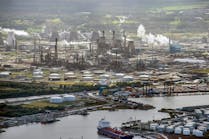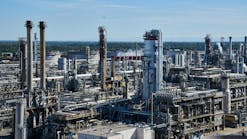Eric Watkins
OGJ Oil Diplomacy Editor
LOS ANGELES, Apr. 16 -- Mexico's Petroleos Mexicanos will spend $12 billion to construct a refinery in Tula and upgrade an existing facility at Salamanca, according to Pemex Chief Executive Officer Jesus Reyes Heroles.
"The portfolio that is most profitable is the construction of new refining capacity in Tula that will process residual fuels and the reconfiguration of Salamanca," Reyes Heroles said.
The aim of both refinery projects is to enable Mexico to reduce the amount of gasoline it imports from the US, or as Reyes Heroles stated, "To avoid continuing to send jobs abroad."
The 300,000 b/d refinery, to cost $9.1 billion, will be built in Tula provided that the regional government secures the necessary land in 100 days, Reyes Heroles said. If not, he said, the project could be sited elsewhere.
The refinery is expected to produce 142,000 b/d of gasoline, 82,000 b/d of diesel, and 12,000 b/d of jet fuel, Pemex said, adding that all of the refinery's products would have "ultralow" sulfur content.
The choice of Tula came after careful scrutiny, as Pemex eyed nine possible sites for the proposed facility, including Cadereyta, Campeche, Dos Bocas, La Cangrejera, Lazaro Cardenas, Manzanillo, Salina Cruz, Tula, and Tuxpan (OGJ Online, Jan. 20, 2009).
A feasibility study Pemex published last August showed that building a 300,000 b/d-capacity refinery in Tula would cost $8.17 billion and provide the highest net present value of the nine locations evaluated.
The most profitable potential locations were those that could utilize residual fuels produced at existing refineries in Tula, Salamanca, and Salina Cruz.
By using such residual fuels, the new Tula facility could make more crude available for export in addition to reducing the need for imported gasoline.
"The issue is: freeing ourselves from fuel oil," said Jose Antonio Ceballos, chief executive of Pemex refining unit Pemex Refinacion. "The number of barrels that we are producing is too high…We have to do away with those barrels."
Reyes Heroles said Pemex plans to begin engineering and design studies and preliminary site preparations this year. Construction of the refinery will begin in 2010, with operations to begin in 2015. The upgrade of the Salamanca refinery is expected to be completed by 2014.
A new bid model
Interest in the tender or tenders is expected to come from "the main Mexican construction firms and several international firms of recognized prestige," Reyes Heroles said.
He said no decision has yet been reached on the exact tender model, but that experience with the reconfiguration of the Minatitlan refinery in Veracruz state "shows us that it has to be done another way."
The Minatitlan reconfiguration was tendered in six packages, each supervised by a separate company—a process that has seen the project repeatedly off schedule and over budget.
"What we are going to do now is use one company supervisor that can not only supervise the other companies, but also help in the definition of criteria for the contracting of others, the evaluation of proposals from others and the definition of tender terms along with Pemex," said Reyes Heroles.
"It will be the first time that we move in this direction," he said.
Mexico, which has not built a refinery since 1979, produced 450,000 b/d of gasoline last year, with additional imports from the US meeting about 40% of the country's needs.
Mexico's gasoline imports for 2008 averaged 336,200 b/d, up 9.1% over 2007, a rise that is expected to continue as domestic demand outstrips production from the country's refineries (OGJ, Feb. 2, 2009, p. 33).
Contact Eric Watkins at [email protected].

